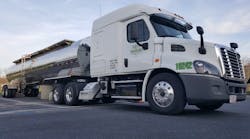Shale energy exploration, the growing practice of deep horizontal drilling to harvest oil and natural gas previously beyond reach, has changed America’s energy industry and overall economy. The fact that natural gas prices are at a 10-year low is a strong indicator of this positive change. And in the areas where the actual drilling occurs--Ohio, Pennsylvania, Texas, Louisiana, and North Dakota, among others--there are even more direct economic impacts of what has been called the “shale boom.”
Benesch, an Ohio based firm with nationally-recognized expertise in transportation law, recently collaborated with National Tank Truck Carriers (NTTC) and the Ohio Trucking Association (OTA) to develop and execute a survey examining the shale boom’s impact on trucking on both a national and state level. Members of each trade association were asked to complete a digital survey designed to explore the current status of trucking as it related to the oil and gas industry and expectations for the future. Surveys were sent to all members of each association, who are spread out geographically across the US and Ohio respectively.
“We decided to look at trucking because, as many economists will tell you, it is an important harbinger of economic vitality and change,” says Richard Plewacki, a partner with Benesch’s Transportation & Logistics practice, “Increases in trucking activity signal corresponding changes in manufacturing and industry. After all, you can’t make or sell a product without transportation playing a key role in the process.”
The Benesch/NTTC/OTA survey found shale activity is having a positive impact on the trucking industry, that this increase in opportunities and presumably profits is expected to continue, and significant job growth will be a byproduct of the trend. The study also sought to identify possible obstacles to future growth in the transportation sector.
“The NTTC was very pleased to work with Benesch on its recent survey,” says Dan Furth, NTTC president. “Given the critical role that our membership plays within the entire shale market, we were not surprised to see the broad level of support as shown through the survey results. I think it’s important to remind some of our friends here in Washington DC that the biggest, most devastating challenge that our country faces is the nation’s continued and embarrassing unemployment rate. You’d think that we could all agree that employing Americans is mission critical to our nation’s long-term economic viability. Increased employment here at home coupled with decreased dependence on foreign oil is a win-win by any measure and so our country’s energy policy demands serious consideration from both sides of the political spectrum. You don’t need a fancy degree to see that sometimes the answer is right in your own backyard. You just need the street smarts to recognize it.”
Some of the survey findings include:
*Huge optimism for positive shale impact: 97% of national respondents believe the shale boom will have a positive impact on the trucking industry. 91% of Ohio truckers believe the shale boom will have a positive impact on their business.
*Ohio has different worries for the future of shale economy than the rest of the nation: In Ohio, overly burdensome regulations--primarily mandatory hours-of-service limitations on truck drivers--are seen as the most significant barrier to capitalizing on shale opportunities. The recruitment and retention of qualified drivers and mechanics was a close second.
Nationally, the greatest barrier to capitalizing on shale opportunities in the trucking industry is the recruitment and retention of qualified drivers and mechanics--nearly 47% cited this as their primary business worry.
It is interesting to note that hours of service (total shift time drivers may work before taking required rest periods) is a federal requirement of all commercial truck drivers. So why did Ohio drivers cite hours of service, and regulation in general, as an impediment to future growth? The answer may be oilfield exemptions. Hours of service exist to keep tired (and, therefore, compromised) drivers from posing a danger on public roadways. Oftentimes drivers who haul supplies to oil and gas drilling sites are required to wait long periods at the site to either unload or load. This idle time is unavoidable. Therefore; oilfield drivers get an exemption to the hours-of-service regulation. Several Ohio respondents reported they felt this practice was unfair in an open-ended portion of the Benesch survey.
While not specifically studied in the Benesch survey, it is possible Ohio truckers balked at regulation more than their counterparts in other states because Ohioans are new to the shale energy industry. With additional experience, it is possible Ohio truckers will adopt views on regulation comparable to drivers in other states.
*The trucking industry has been an early beneficiary of the shale boom: 55% of national respondents say they have experienced some growth in business since 2009 because of shale energy. 27% of Ohio trucking companies report shale activity has driven growth since 2009. Benesch analysts selected 2009 as the target date because it was one year after yield estimates for the Bakken and Marcellus shale plays were made public and, therefore, roughly mark the beginning of development. The Haynesville and Eagle Ford plays were already in production, but the Utica shale play had yet to be identified.
*It’s a trend that is expected to continue: 95% of national respondents anticipate growth in their businesses over the next five years and predict especially robust activity in tank trucking and bulk trucking. 92% of Ohio respondents expect business growth over the next five years; these companies anticipate opportunities in dry van trucking and specialized trucking. 97% of national respondents anticipate a growth in revenues over the next five years while 95% of Ohio companies anticipate the same.
*Job growth in the trucking sector of the economy is explosive: 45% of national respondents expect to grow their workforces anywhere from 5% to 15%, and 11% said they plan to hire between 50% and 100% more employees. 47% of Ohio respondents plan to hire between 5% and 25% more workers over the next five years.
“The survey illustrates the degree to which shale energy is an economic game-changer,” says Plewacki. “High demand for domestic and stable sources of energy is driving shale development at a rapid pace. Ancillary businesses, such as trucking, are reaping tremendous benefits and this can only benefit the economy as a whole. There are, however, threats to this prosperity. The trucking industry needs to develop new ways of finding and retaining drivers and mechanics. Growth isn’t possible without this vital human capital. And trucking companies need find and retain legal professionals to help navigate changes in state regulation and maximize their opportunities.”
The survey took place, via email, in November and December 2012. Benesch developed the questions in partnership with NTTC and OTA. All members of both associations were given the opportunity to participate in the survey. The data-gathering phase of the survey ended on December 18, 2012.








